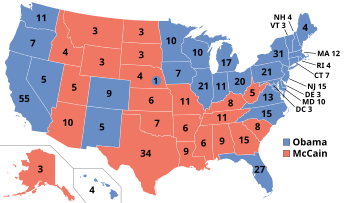US SENATE
Current Senate, 111th Congress: 59 D, 41 R
Current Senate, 111th Congress: 59 D, 41 R
Prediction: Senate, 112th Congress: 54 D, 46 R
Notes: I'm predicting Democratic holds in Illinois (open), Nevada (Harry Reid) and Colorado (Michael Bennet). These three races are essentially tied, and I might be wrong on all of them. Democrats have some chance of turning a Republican seat in Alaska or Kentucky and a chance of holding Pennsylvania. But don't count on it. The loss of Russ Feingold in Wisconsin is devastating. I'm sure I'll have more to say about that later.
US HOUSE
Current House, 111th Congress: 256 D, 179 R
Prediction: House, 112th Congress: 228 R, 207 D
I've never tried to predict the House on a seat-by-seat basis before, so here goes:
Republican gains: AL-2, AR-1, AR-2, AZ-1, AZ-5, CA-11, CO-3, CO-4, FL-2, FL-22, FL-24, GA-2, GA-8, IL-11, IL-14, IN-8, IN-9, KS-3, LA-3, MD-1, MI-1, MI-7, MO-4, MS-1, MS-4, NC-2, NH-1, NH-2, NM-2, ND-AL, NV-3, NY-20, NY-29, OH-1, OH-6, OH-15, OH-16, OR-5, PA-3, PA-7, PA-8, PA-10, PA-11, SC-5, TN-4, TN-6, TN-8, TX-17, TX-23, VA-2, VA-5, WV-1, WA-3, WI-7, WI-8.
Democratic gains: AZ-3, DE-AL, HI-1, IL-10, LA-02, WA-8.
Notes: GOP to gain 49 seats. I've carried a torch just as long as I could for the Democrats to hold onto the House. The pundits and markets however are unanimous on this one: the GOP will gain the 39+ House seats it needs to win control.
The race for control of the House is all about the rust belt. The key to Republican gains this year is the fact that the GOP is going to pick up the Governor's offices in Iowa, Michigan, Ohio, Pennsylvania and Wisconsin and possibly in Illinois. Four of those six races are not even close, and that means that incumbent Democrats down the ticket are going to suffer.
House Democrats got some help in New York with the collapse of Republican Carl Paladino's candidacy for Governor. A poll in late September showed Paladino within 6 points of Attorney General Andrew Cuomo. But that was before a series of homophobic remarks by Paladino left his campaign in freefall, so that by late October the New York Times was showing a 35-point lead for Cuomo. Before Paladino's collapse, many pundits had been predicting that Republicans would pick up at least 4 and possibly as many as 8 Democratic House seats in New York. Now I'm betting that the GOP won't pick up more than 2 seats.
Democratic gains: AZ-3, DE-AL, HI-1, IL-10, LA-02, WA-8.
Notes: GOP to gain 49 seats. I've carried a torch just as long as I could for the Democrats to hold onto the House. The pundits and markets however are unanimous on this one: the GOP will gain the 39+ House seats it needs to win control.
The race for control of the House is all about the rust belt. The key to Republican gains this year is the fact that the GOP is going to pick up the Governor's offices in Iowa, Michigan, Ohio, Pennsylvania and Wisconsin and possibly in Illinois. Four of those six races are not even close, and that means that incumbent Democrats down the ticket are going to suffer.
House Democrats got some help in New York with the collapse of Republican Carl Paladino's candidacy for Governor. A poll in late September showed Paladino within 6 points of Attorney General Andrew Cuomo. But that was before a series of homophobic remarks by Paladino left his campaign in freefall, so that by late October the New York Times was showing a 35-point lead for Cuomo. Before Paladino's collapse, many pundits had been predicting that Republicans would pick up at least 4 and possibly as many as 8 Democratic House seats in New York. Now I'm betting that the GOP won't pick up more than 2 seats.
GUBERNATORIAL
Democrats to pickup CA, CT, HI, MN, FL and VT.
Republicans to pickup IA, KS, ME, MI, OH, OK, NM, PA, TN and WI.
Independent to pickup RI.
Republicans to pickup IA, KS, ME, MI, OH, OK, NM, PA, TN and WI.
Independent to pickup RI.
Notes: The races in Florida, Oregon and Vermont are all extremely close, but I'm making the same call as Nate Silver of the New York Times on all three, so I'm probably in good shape. The controversial pick here is that Governor Quinn will hold on in Illinois. I just don't believe that the Illinois GOP has a strong enough get-out-the-vote machine to win.
